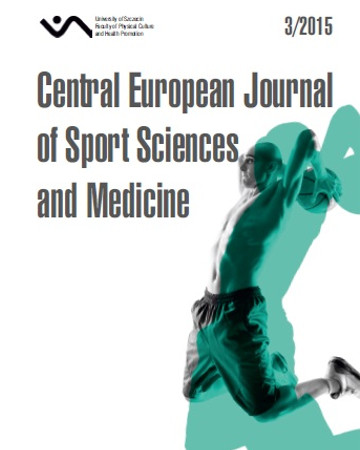
ISSN: 2300-9705
eISSN: 2353-2807
OAI
DOI: 10.18276/cej.2015.3-15




Lista wydań /
Vol. 11, No. 3/2015
Analysis of the Longest Distances Run by the Best Soccer Players at the FIFA World Cup in Brazil in 2014
| Autorzy: |
Łukasz
Bojkowski
PhD student, Department of Psychology, University School of Physical Education, Poznań, Poland Jerzy Eider Faculty of Physical Culture and Health Promotion, University of Szczecin, Poland Robert Śliwowski Department of Team Games, University School of Physical Education, Poznań, Poland Andrzej Wieczorek Department of Team Games, University School of Physical Education, Poznań, Poland |
| Słowa kluczowe: | World Cup distance run soccer |
| Data publikacji całości: | 2015 |
| Liczba stron: | 7 (145-151) |
Abstrakt
The aim of the study was, among other things, to characterise the maximum distance run by the four best teams in the FIFA World Cup in Brazil, including individual tactical formations and players who played for at least 90 minutes in the whole tournament. In total, the highest results of 68 players were established. In the analysis data obtained using Castrol Performance Index method were used. The mean maximum distance run by players of the tournament semi-finalist teams in the 24 analysed games was 11.63 km. The mean by the analysed defenders was 11.75 km, whereas for midfielders it was 12.02 km, for forwards – 11.02 km, and for goalkeepers – 5.65 km. In group of all 68 respondents soccer players a distance of over 15 km in one game was obtained by Bastian Schweinsteiger, Thomas Müller and Lucas Biglia.
Pobierz plik
Plik artykułu
Bibliografia
| 1. | Bangsbo J., Lorregaard L., Thorsoe F. Activity profile of competition soccer. Can J Sports Sci. Jun. 1991; 16 (2): 110–116. |
| 2. | Barros R.M.L., Misuta M.S., Menezes R.P., Figueroa P.J., Moura F.A., Cunha S.A., Anido R., Leite N.J. Analysis of the distances covered of First Division Brazilian soccer players obtained with an automatic tracking method. Journal of Sport Science and Med |
| 3. | Bradley P.S., Sheldon W., Wooster B., Olsen P., Boanas P., Krustrup P. High-intensity running in English FA Premier League soccer matches. Journal of Sports Sciences. 2009; 27 (2): 159–168. |
| 4. | Di Salvo V., Baron R., Tschan H., Calderon Montero F.J., Bachl N., Pigozzi F. Performance Characteristics According to Playing Position in Elite Soccer. Int J Sports Med. 2007; 28 (3): 222–227. |
| 5. | Helgerud J., Engen L.C., Wisloff U., Hoff J. Aerobic endurance training improves soccer performance. Med. Sci. Nov. 2001; 33 (11): 1925–1931. |
| 6. | Jastrzębski Z. Zakres obciążeń treningowych w piłce nożnej i ręcznej a ich wpływ na rozwój sportowy zawodników. AWFiS, Gdańsk, 2005. |
| 7. | O`Donoghue P.G. Normative profiles of sports performance. Inter. J. Perform. Anal. Sport. 2005; 5 (1): 104–119. |
| 8. | Sang Duk O., Sung Min K., Kawczyński A., Chmura P., Mroczek D., Chmura J. Endurance and Speed Capacity of the Korea Republic Football National Team During the World Cup of 2010. Journal of Human Kinetics. 2011; 30: 115–121. |
| 9. | Reilly T., Bangsbo J., Franks A. Anthropometric and physiological predispositions for elite soccer. J. Sports Sci. 2000; 18: 669–683. |
| 10. | Stølen T., Chamari K., Castagna C., Wisløff U. Physiology of Soccer An Update. Sports Med. 2005; 35 (6): 501–536. |
| 11. | Wilmore J., Costill D. Physiology of Sport and Exercise. Human Kinetics. Champaign 1999. |